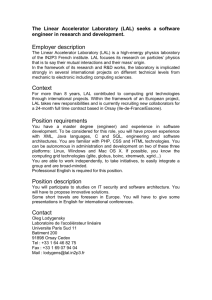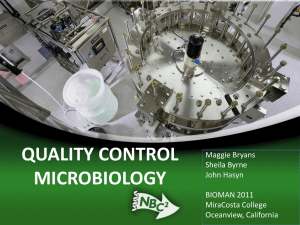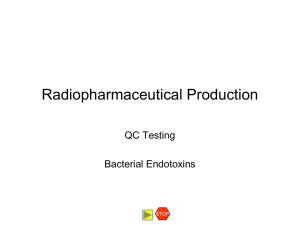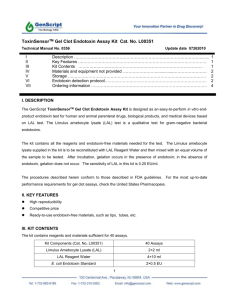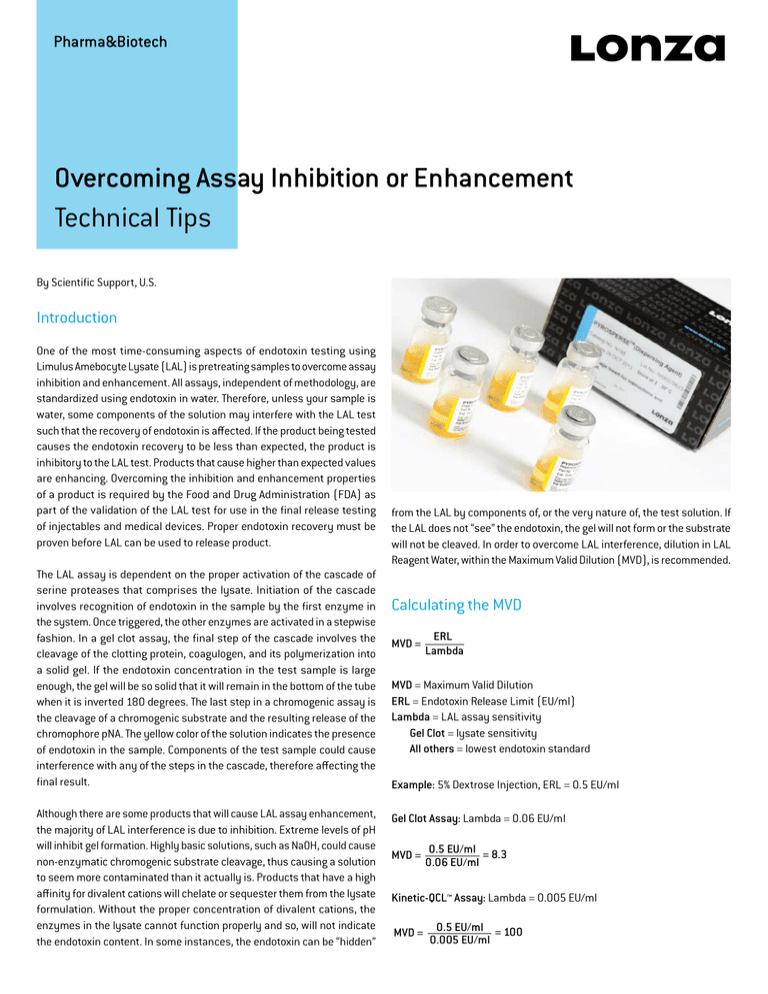
Pharma&Biotech
Overcoming Assay Inhibition or Enhancement
Technical Tips
By Scientific Support, U.S.
Introduction
One of the most time-consuming aspects of endotoxin testing using
Limulus Amebocyte Lysate (LAL) is pretreating samples to overcome assay
inhibition and enhancement. All assays, independent of methodology, are
standardized using endotoxin in water. Therefore, unless your sample is
water, some components of the solution may interfere with the LAL test
such that the recovery of endotoxin is affected. If the product being tested
causes the endotoxin recovery to be less than expected, the product is
inhibitory to the LAL test. Products that cause higher than expected values
are enhancing. Overcoming the inhibition and enhancement properties
of a product is required by the Food and Drug Administration (FDA) as
part of the validation of the LAL test for use in the final release testing
of injectables and medical devices. Proper endotoxin recovery must be
proven before LAL can be used to release product.
The LAL assay is dependent on the proper activation of the cascade of
serine proteases that comprises the lysate. Initiation of the cascade
involves recognition of endotoxin in the sample by the first enzyme in
the system. Once triggered, the other enzymes are activated in a stepwise
fashion. In a gel clot assay, the final step of the cascade involves the
cleavage of the clotting protein, coagulogen, and its polymerization into
a solid gel. If the endotoxin concentration in the test sample is large
enough, the gel will be so solid that it will remain in the bottom of the tube
when it is inverted 180 degrees. The last step in a chromogenic assay is
the cleavage of a chromogenic substrate and the resulting release of the
chromophore pNA. The yellow color of the solution indicates the presence
of endotoxin in the sample. Components of the test sample could cause
interference with any of the steps in the cascade, therefore affecting the
final result.
Although there are some products that will cause LAL assay enhancement,
the majority of LAL interference is due to inhibition. Extreme levels of pH
will inhibit gel formation. Highly basic solutions, such as NaOH, could cause
non-enzymatic chromogenic substrate cleavage, thus causing a solution
to seem more contaminated than it actually is. Products that have a high
affinity for divalent cations will chelate or sequester them from the lysate
formulation. Without the proper concentration of divalent cations, the
enzymes in the lysate cannot function properly and so, will not indicate
the endotoxin content. In some instances, the endotoxin can be “hidden”
from the LAL by components of, or the very nature of, the test solution. If
the LAL does not “see” the endotoxin, the gel will not form or the substrate
will not be cleaved. In order to overcome LAL interference, dilution in LAL
Reagent Water, within the Maximum Valid Dilution (MVD), is recommended.
Calculating the MVD
MVD =
ERL
Lambda
MVD = Maximum Valid Dilution
ERL = Endotoxin Release Limit (EU/mI)
Lambda = LAL assay sensitivity
Gel Clot = lysate sensitivity
All others = lowest endotoxin standard
Example: 5% Dextrose Injection, ERL = 0.5 EU/mI
Gel Clot Assay: Lambda = 0.06 EU/mI
MVD = 0.5 EU/ml = 8.3
0.06 EU/ml
Kinetic-QCL™ Assay: Lambda = 0.005 EU/mI
MVD =
0.5 EU/ml = 100
0.005 EU/ml
Pharma&Biotech
Overcoming Assay Inhibition or Enhancement
For some products, dilution to the MVD with LAL Reagent Water alone
will not be successful in removing all of the LAL interference. In some
instances, an alternative diluent is necessary. For example, products that
are highly acidic or highly basic may require pH adjustment or dilution with
a buffer. Of course, whenever anything is added to a product, steps must
be taken to help ensure that no endotoxin is added. Diluents must be made
with LAL Reagent Water (or equivalent) in endotoxin-free containers. The
endotoxin content of the alternative diluent must be determined prior to
use. If endotoxin is detected in the diluent, the endotoxin must be removed.
Filtration through a pyrogen-free 10,000-20,000 molecular weight cutoff
ultrafilter will remove endotoxin from solutions. Once the solution is free
of detectable endotoxin, it can be used to dilute the inhibitory product.
To save customers the time and effort of making endotoxin-free
solutions for use as alternative diluents, Lonza offers three solutions for
overcoming LAL testing inhibitions. All three of these products are tested
for functionality and endotoxin content. Two of these products are simple
solutions that will make your LAL testing easier. Catalog No. S50-641 is
a 10 mM MgCl2 Solution and Catalog No. S50-642 is a 50 mM Tris Buffer
Solution. The other member of the trio, PYROSPERSE™, Catalog No. N188, is
our proprietary dispersing agent. The remainder of this article will provide
examples of the use of these three products.
Use MgCl2 to Overcome Chelation Effect
Heparin is an anticoagulant. Because LAL is composed of the coagulation
system of the horseshoe crab, heparin manufacturers find that their
product also inhibits LAL gel formation. Heparin seems to chelate the
divalent cations in the LAL formulation, thus depleting the enzymes in the
lysate of the cations they need to function properly. Diluting the heparin
sample in water diminishes the inhibition, however, the dilution factor
cannot exceed the MVD. Reconstituting and/or diluting the heparin in a
solution containing divalent cations, such as MgCl2, will help overcome the
inhibitory nature of heparin and decrease the necessary dilution factor.
The heparin will chelate cations from the diluent. Therefore, when it is
mixed with the LAL, the heparin will not remove cations from the lysate.
For example, tests showed that when 2 ml of LAL Reagent Water was added
to blood collection tubes containing 30 USP units of heparin, the Positive
Product Control (PPC) recovery for a tested aliquot was 42%, just below
the acceptable range of 50–200% for a Kinetic-QCL™ Assay (see Table
1). The heparin is inhibitory to the assay. If 2 ml of 10 mM MgCl2 was
added to the heparinized tubes, then the PPC recovery, 118%, is within
the acceptable range. Using 10 mM MgCl2 to dilute heparin or other cationchelating products will help your product easily pass the LAL inhibition/
enhancement test.
Adjust the pH with Tris Buffer
The LAL assay functions best in the 6.0 to 8.0 pH range. If a product is
outside that pH range, pH adjustment may be necessary. Lonza LAL is
buffered, so simple dilution of products in LAL Reagent Water may be
sufficient to render the product testable. Adjusting the pH of an unbuffered
solution with endotoxin-free acid or base is not recommended. Often
times, the desired pH is overshot several times during the adjustment,
thus altering the ionic strength of the solution just enough to inhibit LAL
functionality. Instead, a buffer in the correct pH range is recommended
as a diluent for acidic and basic product solutions. Lonza Tris Buffer, for
use with LAL, is a 50 mM solution with an appropriately neutral pH. This
Tris Buffer is recommended for use with products that are outside the
acceptable pH range. Whereas a 1:10 diIution of such a product in water
may remain inhibitory, the same dilution in the Tris Buffer may yield
acceptable spike recovery results. Table 1 includes example data. Here,
0.01 N HCI was diluted 1:10 with LAL Reagent Water and tested with the
Kinetic-QCL™ Assay. The percent recovery of the 0.5 EU/mI PPC was 28%,
indicating that the solution is inhibitory to the assay. When the 0.01 N HCI
solution was diluted 1:10 with the 50 mM Tris Buffer, the percent recovery
was 98%. This is well within the FDA required 50–200% recovery range.
Sample
Diluent
Endotoxin Content
PPC% Recovery
Heparin (30 units)
LAL Reagent Water
<0.005 EU/mI
42%
10 mM MgCI2
<0.005 EU/mI
118%
LAL Reagent Water
<0.005 EU/mI
28%
50 mM Tris Buffer
<0.005 EU/mI
98%
HCI (0.01 N)
Table 1. Examples of the PPC recoveries with LAL Reagent Water and alternative sample
diluents. The LAL assay used was the Kinetic-QCL™ Assay from Lonza.
Try PYROSPERSE™ to Solve Aggregation Problems
Endotoxin is a molecule with a split personality. The polysaccharide portion
of endotoxin likes to be in an aqueous environment. The lipid portion,
however, is hydrophobic. As a result of its nature, endotoxin monomers
will aggregate such that the lipid portion is hidden from the aqueous
solution. It is the lipid portion of the endotoxin molecule that activates
the LAL reagent. Some products will actually attract and hide endotoxin. In
order to detect endotoxin in these products, the endotoxin must be coaxed
from its preferred environment. Detergents or surfactants can be used
to dissociate endotoxin from itself and products; much like dishwashing
liquid disperses grease in a water-filled frying pan. PYROSPERSE™, Catalog
No. N188, is a metallo-modified polyanionic dispersing agent. For the gel
clot method, a 2% PYROSPERSE™ solution is recommended for use as
a diluent. A 0.5% solution should be used with the chromogenic assays
QCL-1000™ or Kinetic-QCL™. Higher concentrations of PYROSPERSE™ may
inhibit the LAL test. Dilution of a sample with the appropriate concentration
of PYROSPERSE™ plus a vigorous vortexing can help to dissociate endotoxin
aggregates. PYROSPERSE™ will change the environment of the solution just
enough that the endotoxin is now more “comfortable” and it will expose its
lipid portion to the LAL. In 1982, Guilfoyle and Munson published a report
Pharma&Biotech
Overcoming Assay Inhibition or Enhancement
documenting that the use of PYROSPERSE™ would increase the amount of
detectable endotoxin in inhibitory products (Dennis E. Guilfoyle and Terry
Munson, “Procedures for Improving Detection of Endotoxin in Products
Found Incompatible for Direct Analysis with Limulus Amebocyte Lysate,”
in: Endotoxins and Their Detection with the Limulus Amebocyte Lysate
Test, Alan R. Liss, Inc., New York, 1982). The data included in the report
showed that dilution of the inhibitory products in 2% PYROSPERSE™ (for
the gel clot assay performed) yielded 2 to 175-fold endotoxin detection
improvements.
Final Recommendations
An example of a product that can be successfully LAL tested with
PYROSPERSE™ is hyaluronic acid. This product will not go into solution
in water, even with vigorous vortexing. Hyaluronic acid, 500 mg, was
made soluble, with 4% PYROSPERSE™ in water. This solution was further
diluted to 0.5 ng/ml in water and tested with the Kinetic-QCL™ Assay. The
percent recovery of the 0.5 EU/ml PPC for this sample was 139%, which
is within the acceptable recovery range. Although the PYROSPERSE™
concentration used to dissolve the product was higher than what is
recommended in the PYROSPERSE™ Product Insert, dilution of the
hyaluronic/PYROSPERSE™ mixture within the MVD with LAL Reagent Water
yielded acceptable endotoxin spike recoveries in a Kinetic-QCL™ inhibition/
enhancement assay.
Inhibition and enhancement testing is an integral part of the validation
process for the use of LAL in the final release of products. The United
States Pharmacopeia (USP) Chapter 85, Bacterial Endotoxins Test, allows
for pretreatment of products to render them testable. As long as it can
be demonstrated that the pretreatment allows for the recovery of added
(spiked) endotoxin, within the acceptable limits of the LAL method being
used, the pretreatment will be acceptable. Once a pretreatment is found
that will successfully overcome the inhibition or enhancement of at least
three lots of the product, the product can be validated for release with
LAL. For routine testing of products, the product must be prepared in
the manner in which it was treated to pass the inhibition/enhancement
test. Otherwise, a negative result may be mistaken as indicating a lack
of endotoxin in the product, when in reality, the negative is a result of
inhibition.
It is not appropriate to use the pretreatment on the endotoxin standards.
The “gold standard” in LAL testing is endotoxin in water, which is also used
for the standard curves required in LAL testing. Pretreatment of samples
is necessary to make the samples behave more like endotoxin in water. If
the pretreatment is used to prepare the endotoxin standards, the activity
of the standards may be altered. This changes the “gold standard” and
could adversely affect the assay results.
Contact Information
North America
Customer Service: 800 638 8174 (toll free)
order.us@lonza.com
Scientific Support: 800 521 0390 (toll free)
scientific.support@lonza.com
Lonza Walkersville, Inc. – Walkersville, MD 21793
Europe
Customer Service: +32 87 321 611
order.europe@lonza.com
Scientific Support: +32 87 321 611
scientific.support.eu@lonza.com
Unless otherwise noted, all trademarks herein are marks of the Lonza Group Ltd or its affiliates. The
information contained herein is believed to be correct and corresponds to the latest state of scientific
and technical knowledge. However, no warranty is made, either expressed or implied, regarding its
accuracy or the results to be obtained from the use of such information and no warranty is expressed or
implied concerning the use of these products. The buyer assumes all risks of use and/or handling. Any
user must make his own determination and satisfy himself that the products supplied by Lonza Group
Ltd or its affiliates and the information and recommendations given by Lonza Group Ltd or its affiliates
are (i) suitable for intended process or purpose, (ii) in compliance with environmental, health and safety
regulations, and (iii) will not infringe any third party’s intellectual property rights.
International
Contact your local Lonza distributor
Customer Service: +1 301 898 7025
Fax:
+1 301 845 8291
scientific.support@lonza.com
© Copyright 2012, Lonza Walkersville, Inc. All rights reserved.
TS-LALInhEnh 11/12
www.lonza.com/accessories
3
RT-DS005

